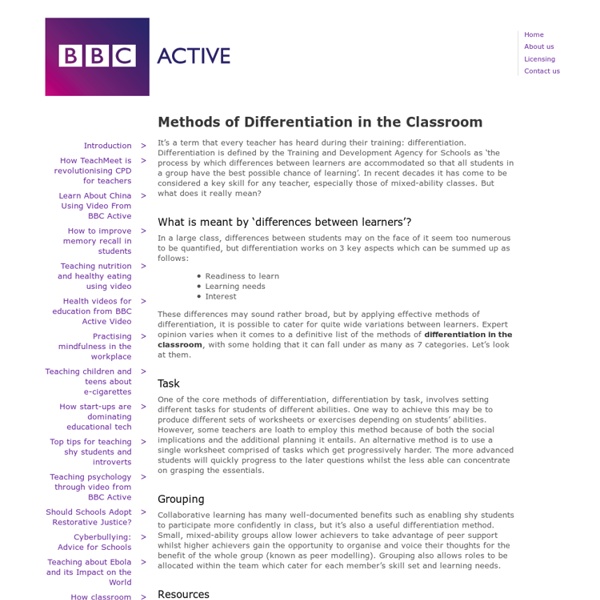



8 Lessons Learned on Differentiating Instruction My differentiation journey began in 2004 when my principal asked me to attend a weeklong summer conference on differentiated instruction. I was eager to please my principal so I quickly accepted her offer. I was also extremely curious about how I, one person, could possibly address the individual needs of 100 students. By the end of the conference, I was totally overwhelmed with information: flexible grouping, assessment, inventories, tiered lessons, Carol Ann Tomlinson. Throughout that year, I utilized a variety of management pointers for a differentiated classroom that had been presented during the conference. Lesson 1 Differentiation does not take place overnight; think of it as a wonderful work in progress. Lesson 2 Like students themselves, differentiation can take on many forms. Content: What the students learn Process: Activities used to assist the learning Products: Demonstration of learning The methods you use should be based on the student's needs: Lesson 3 Lesson 4 Lesson 5 Lesson 6
What Is Differentiated Instruction? Click the "References" link above to hide these references. Csikszentmihalyi, M. (1997). Finding Flow: The Psychology of Engagement with Everyday Life. New York: Basic Books. Danielson, C. (1996). Sternberg, R. Tomlinson, C. (1995). Tomlinson, C. (1999). Vygotsky, L. (1986). Winebrenner, S. (1992). Differentiation
Differentiated Instruction: Resource Roundup Understanding Differentiated Instruction Summer DI Readings List: 150+ Seedlings for Growing Stronger Learners: Browse a bountiful reading list as you plan your garden of differentiated-instruction methods and strategies for the year. (Edutopia, 2015) Myth-Busting Differentiated Instruction: 3 Myths and 3 Truths: Get to the bottom of common misconceptions about differentiated instruction. Planning and Implementation Ideas Levels of Understanding: Learning That Fits All: Learn how to develop a framework to support creating homework or practice to meet the needs of all learners. Knowing and Assessing Students Make Learning Last: How Diverse Learners Can Process Their Understanding: Find out how quick reflections, surveys, and diverse-perspective assessments can help students to process more deeply and check their own understanding. Teaching Diverse Learners Equity vs. Differentiating With Technology Differentiation in Project-Based Learning Examples and Downloads From Schools That Work video
Differentiation A Collection Of The Best “Laugh While You Cry” Videos — Contribute More! Valerie Strauss at The Washington Post today published another great animation illustrating some of the bizarre situations teachers can find themselves in when the latest school reform fads and “lingo” get embraced by some adminstrators. I thought it would be useful to collect that one, and the others I’ve published, into one place, and add more in the future. I hope others will contribution new ones, too. Here are The Best “Laugh While You Cry” Videos (if you are reading this on an RSS Reader, you might have to go directly to the post to see them all): This is the video Valerie shared today. Here’s the first one on “collaborative planning”: This one is also on collaboration: Here’s one called “Focus Walk” Dan Brown created this imagined interview with Cathie Black, the newly nominated Chancellor of New York Schools. Eduflack is the pen name of Patrick Riccards, who provides genuinely thoughtful commentary on education issues. “The Daily Show” with Diane Ravitch was a classic. Related
Differentiating Instruction Differentiating Instruction: Rethinking Traditional Practices Bertie Kingore, Ph.D. Differentiating instruction invites educators to rethink traditional educational practices that were based upon a time when students were more similar in background and readiness. Differentiation is a well known educational practice that is often talked about, sometimes not well understood, and frequently implemented ineffectively. When readiness levels differ, so must the complexity of instruction provided for students. Learning takes place only when students experience instruction at a level of difficulty that is appropriately challenging and attainable (Tomlinson, 2003; Wolfe, 2001). Students are individuals. Rather than whole-class instruction dominating, small groups of students frequently work together or with the teacher on different levels of concepts and skills. Differentiation switches the assessment and evaluation focus from competition among all students to a student competing with self.
SEDL - SCIMAST Classroom Compass In recent years educators have explored links between classroom teaching and emerging theories about how people learn. Exciting discoveries in neuroscience and continued developments in cognitive psychology have presented new ways of thinking about the brain-the human neurological structure and the attendant perceptions and emotions that contribute to learning. Explanations of how the brain works have used metaphors that vary from the computer (an information processor, creating, storing, and manipulating data) to a jungle (a somewhat chaotic, layered world of interwoven, interdependent neurological connections). Scientists caution that the brain is complex and, while research has revealed some significant findings, there is no widespread agreement about their applicability to the general population or to education in particular. Opportunities for Learning Most neuroscientists believe that at birth the human brain has all the neurons it will ever have. Emotions and the Mind Caine, R.